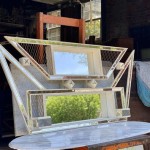Which of the Three Mirrors is a Convex Mirror?
Mirrors are ubiquitous objects, playing crucial roles in everyday life, scientific instruments, and technological applications. They manipulate light to create reflections, and their shapes dictate the characteristics of these reflections. Three common types of mirrors exist: plane, concave, and convex. Understanding the differences between these mirror types is essential for predicting and utilizing their reflective properties.
A plane mirror, the most familiar type, possesses a flat reflective surface. Incident light rays striking a plane mirror reflect at an angle equal to the angle of incidence. This results in an image that appears the same size as the object, upright, and located behind the mirror at a distance equal to the object's distance from the mirror. This type of image is referred to as a virtual image, meaning it cannot be projected onto a screen.
Concave mirrors, on the other hand, have a reflective surface that curves inward, like the inside of a bowl. The behavior of light reflecting off a concave mirror is more complex than with a plane mirror. Parallel light rays striking a concave mirror converge at a single point called the focal point. The distance between the focal point and the mirror's center is known as the focal length. The curvature of the mirror determines the focal length: a more strongly curved mirror has a shorter focal length.
The type of image formed by a concave mirror depends on the object's position relative to the focal point. If an object is placed beyond the focal point, the reflected rays converge to form a real image. Real images are inverted (upside down) and can be projected onto a screen. If the object is placed between the focal point and the mirror, the reflected rays diverge, producing a virtual image that is upright and magnified.
Finally, convex mirrors have a reflective surface that curves outward, like the outside of a sphere. Parallel light rays striking a convex mirror diverge after reflection, appearing to originate from a virtual focal point located behind the mirror. Similar to concave mirrors, the curvature of a convex mirror determines its focal length: a more strongly curved mirror has a shorter focal length. The focal length of a convex mirror is, by convention, considered negative.
Unlike plane and concave mirrors, convex mirrors always produce virtual images, regardless of the object's position. These images are upright, diminished (smaller than the object), and located behind the mirror. The field of view of a convex mirror is wider than that of a plane or concave mirror of similar size, making them useful in applications where a wide viewing angle is required.
Therefore, of the three types of mirrors - plane, concave, and convex - the convex mirror is the one with a reflective surface that curves outward. This outward curve causes incident light rays to diverge, resulting in distinctive image characteristics: a virtual, upright, and diminished image with a wider field of view.
The unique properties of convex mirrors make them valuable in a variety of practical applications. One common example is their use as passenger-side mirrors in vehicles. The wider field of view allows drivers to see a larger portion of the road behind them, though the diminished size of the image necessitates the warning often printed on these mirrors: "Objects in mirror are closer than they appear."
Convex mirrors are also frequently employed in security applications, such as in stores or at blind corners in hallways. The wide field of view allows for monitoring a larger area with a single mirror. Additionally, the diminished size of the image allows more of the scene to be compressed into the mirror's view, further enhancing surveillance capabilities.
Beyond these common applications, convex mirrors also find use in scientific instruments. For example, some telescopes incorporate convex mirrors as part of their optical systems to gather and focus light. In these applications, the specific curvature of the mirror is carefully designed to achieve the desired optical properties.
In summary, differentiating between plane, concave, and convex mirrors hinges on understanding the shape of their reflective surfaces and how this shape influences the reflection of light. Plane mirrors produce virtual, upright, and same-sized images. Concave mirrors can produce both real and virtual images, depending on the object's position relative to the focal point. Convex mirrors, with their outward-curving surface, consistently produce virtual, upright, and diminished images with a wider field of view, making them suitable for various applications requiring a broadened perspective.

Section 4 Mirrors Nitty Gritty Science

Figure A Shows Three Incident Rays 1 2 And 3 Falling On Convex Mirror Ray Falls Parallel Making An Angl Physics Physical Science

Image Formation By Mirrors Physics Ii

Spherical Mirrors

Concave Mirrors And Convex Image Formation Ray Diagram

Ray Tracing

Convex Mirror Uses Of Definition Equation

Convex Mirror Definition Equation Examples Lesson Study Com

Concave And Convex Mirrors

Image Formation By Mirrors Physics Ii








